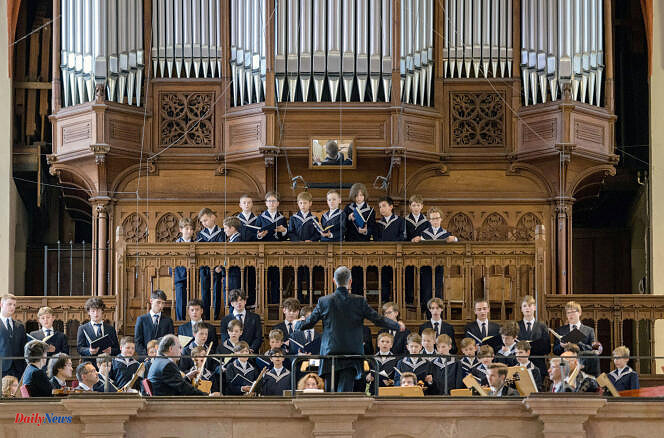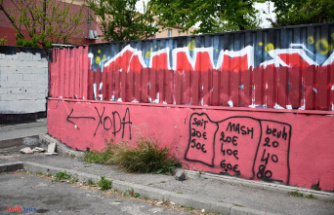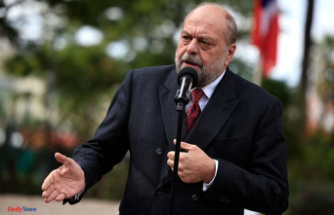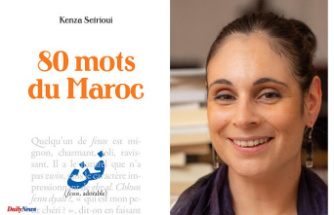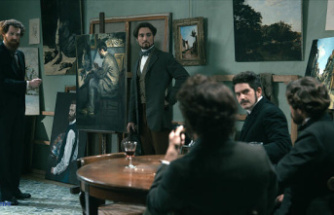Let us imagine, through a Doctor Who-style science fiction twist, that Johann Sebastian Bach (1685-1750) was in the church that was his home for the last twenty-seven years of his life in as cantor (chapel master) of Saint-Thomas in Leipzig, the day when this Passion according to Saint John was recorded by Arte, which broadcast it three hundred years after its creation, on Good Friday in the year 1724 (but in another church in the city, Saint-Nicolas).
He would not recognize its Thomaskirche, rather spared from the bombings of the Second World War, but rebuilt in such a way as to restore the first structures, masked by baroque elements which have now disappeared; he would not find the organs of his time, replaced by instruments from the 19th and 21st centuries, and he would surely wonder why the organist plays on a small portable model that has been mounted on the gallery rather than on the instrument at pipes on which, in his time, the accompaniment was performed (sometimes also on the harpsichord).
Operatic theatricality
He would surely be surprised if the cellos in the orchestra had endpins (in his time, the instrument was held between the calves), the violins and violas had chin rests. It is also likely that the cantor would not be very happy with the quality of the changed voices (tenors and bass) of the choir, adolescents with still imperfect technique. But he had already experienced this in his time, with the brats, pubescent or not, of the Thomasschule – a school founded in 1212 –, whom he readily described as “incapable”.
However, Bach would probably be happy to hear again the very first version of his first Passion, the St. John, which he performed again four times until 1749, a year before his death, notably because of a city and d a conservative clergy who were embarrassed, in addition to Bach's interpretation of biblical texts, by the operatic theatricality of the recitatives and action choruses of this vehement Passion (four years before his arrival at Saint-Thomas, vespers were still given of Good Friday, a Passion in Gregorian chant).
This version of 1724 differs significantly from the one we hear today most often in concerts and on records (the following version, dated 1725, replaces the famous entrance chorus with a chorale, which will later be used in the Passion according to Saint Matthew): despite changes in the line of the story of the evangelist – the narrator of the Passion – and in the airs, most of the structure desired by Bach is in place.
On the podium, the Thomaners are accompanied by the Leipzig Gewandhaus Orchestra, founded in 1743, of which Felix Mendelssohn was one of the musical directors, who brought Bach's two Passions back to life: the "Great Passion", as they said of Saint Matthew, in 1829, and Saint John, in 1833. The orchestra plays a fairly convincing imitation baroque style, encouraged by Riccardo Chailly, its musical director from 2005 to 2016, who had conducted the two Passions in concert and recorded Saint Matthew for Decca in 2010.
Unequal lineup of soloists
This St. John's anniversary concert is conducted by Bach's current successor, Andreas Reize (48), who has been the eighteenth cantor of St. Thomas since September 11, 2021. He has two particularities: he is Swiss and of Catholic obedience (however, he had to convert to Lutheranism). A good musician, historically informed, Reize plays rather fast tempos (which Bach himself did, according to some accounts).
However, we regret the too many affectations with which his direction bestows certain choirs, with magnifying glass and acceleration effects that are not always welcome. The continuo is quite talkative and the organist even plays short interludes. It is also a shame that a historical reconstruction of the liturgy was not chosen, with the famous sermon which separated the two parts of the Passion and other musical interventions.
The line-up of soloists is uneven: soprano Anna Prohaska sings low, countertenor Andreas Scholl no longer has the voice of his youth, tenor Raphael Wittmer struggles in two arias, which are admittedly very difficult. Tomas Kral embodies a simple and straight Christ, while the baritone Tobias Berndt is part of the dual tradition of Dietrich Fischer-Dieskau and Max van Egmond, a Dutch singer associated with recordings of Bach's cantatas and Passions by Gustav Leonhardt and Nikolaus Harnoncourt.
But the most exceptional among them all is Julian Prégardien, a moving evangelist with a supple and impeccable vocality, coupled with perfect diction, who manages to be heartbreaking while remaining modest throughout the story of the Passion of Christ.

